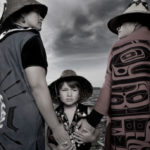BRETT ZONGKER
Associated Press
WASHINGTON (AP) _ A “time capsule” of photographs documenting the descendants of slaves on a long-isolated island off the South Carolina-Georgia coast will have a new home at the Smithsonian’s African-American history museum.
Bank of America, which has a vast art collection it lends to museums, is donating a collection of 61 photographs by Jeanne Moutoussamy-Ashe, the wife of the late tennis player Arthur Ashe, to the museum on Monday. Officials tell The Associated Press the bank will also give $1 million to help build the $500 million museum. This is the bank’s second $1 million donation.
Between 1977 and 1981, Moutoussamy-Ashe, a celebrated African-American photographer, documented the Gullah/Geechee people who lived in isolation on Daufuskie Island near Savannah, Ga., and Hilton Head, S.C. The island has no bridge to the mainland, and it didn’t have electricity or telephone service until the 1950s.
At the time of the photography project, fewer than 84 permanent residents lived on the island, supporting themselves by catching oysters and growing cotton. The island had a co-op store, a two-room schoolhouse and a church.
Moutoussamy-Ashe said she observed a pure and simple life. At first, she didn’t pick up her camera because she wanted to get to know the people, and she developed a strong connection with them at a time before new development began to creep in.
“My intent at 25 was to photograph what I saw as a dying culture, but at 62 now, I really see it was probably quite presumptuous of me to think that people wanted that,” she said.
She said it was an honor to give these direct descendants of slaves a place in an African-American museum.
“To give this just incredible, warm, giving, nurturing community of people recognition that they were able to thrive as long as they did, that to me is a testament to them and to our culture,” Moutoussamy-Ashe said.
Lonnie Bunch, the museum’s director, said the donation builds on a growing collection of photographs in the museum’s collection, which also includes early images of Frederick Douglass and the work of South African photographer Gordon Clark.
“Daufuskie Island is one of those places that was almost a time capsule,” Bunch said. “It was very important to capture that. That’s what these photographs do.”
Merrill Lynch, now part of Bank of America, purchased the Daufuskie Island collection in 2007, and the images have been exhibited at museums in New York, Atlanta, Houston, Charleston, S.C., and Los Angeles.
“This is a very special culture, one that has kind of stayed intact, captured by Jeanne as it was in the 70s,” said Rena DeSisto, the bank’s head of global arts and culture. “But what she’s captured is what it also looked like in the 1870s.”
The bank has an art collection of about 10,000 works and lends items free of charge to museums for about 10 to 12 shows a year. The bank has been supporting the Smithsonian’s black history museum since its earliest stages of development, DeSisto said.
After years of planning, about 30 percent of the museum building is now completed on the National Mall. Exhibits have been designed, and curators are narrowing down what will be put on display first. The museum is also working to create about 130 media pieces, including video installations.
So far, $410 million has been raised for the $500 million project, with Congress contributing half the funds. Oprah Winfrey is the project’s largest individual donor, contributing $13 million.
The Smithsonian’s goal is to open the museum in November 2015. But trouble with water in an underground structure took additional time and could push the completion date into early 2016, Smithsonian officials have said.
National Museum of African American History and Culture: http://nmaahc.si.edu











